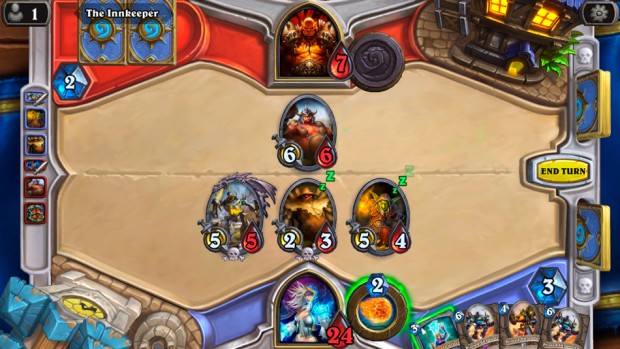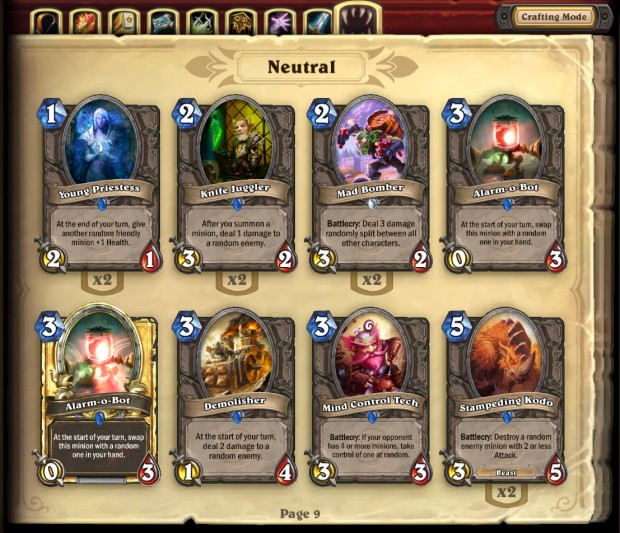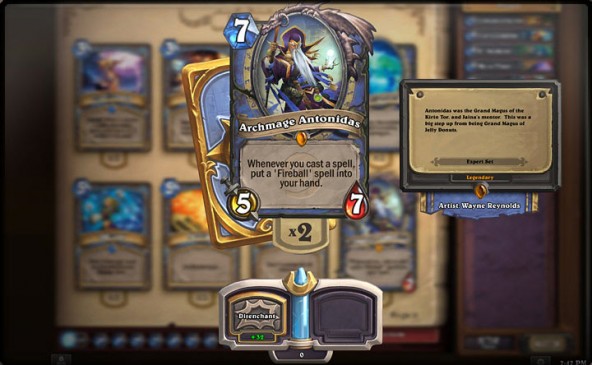Hearthstone: Stuck in a Rut
The wonder and excitement over getting a few new cards from Blackrock Mountain has just about subsided. Soon, Hearthstone players will fall back into the between-releases doldrums, doing a few daily quests here and there or piddling about in the Arena (yay, another Goblins & Gnomes pack), or, in my case, trying to best my oh-so-impressive rank 13 high point as I wait for the next drop of cards, probably around the end of the year. Probably.
I was struggling to figure out what the underlying reason was for my ennui, when I read Luke Winkle's piece on Daily Dot. I'm not sure that he can attribute all of Hearthstone's woes to it being free-to-play, but he raises a lot of good points, anchored around the following notion: It's a solid game, but Blizzard just isn't doing anything with it right now other than the bare minimum.
I think Blizzard's in an unusual spot with Hearthstone; it was conceived almost on a whim, in a “let's see if we can do this” way, and Blizzard's always touted its “small team” as a good thing. It's likely grown from the 20 people named in that article, which was written over a year ago, but when your other games employ hundreds of employees – and probably rake in a lot more cash – it can be hard to get additional resources to spruce up anything beyond absolute necessities, like the occasional new card set. This isn't to say that I think the size of the Hearthstone dev team should equal World of Warcraft's; having worked for sports trading-card companies that tentatively dipped a toe into trading-card games, that's just how it is.
That last article says that a major benefit of a small dev team is that “it allows developers to interact and discuss mechanics before implementing them,” and Eric Dodds mentions being able to shout over the wall and get instant feedback from everyone on the team, rather than having to endure a week-long e-mail chain. If a small team makes communication speedier, though, it doesn't show in the speed of actual releases. In the TCG world, three sets a year is standard operating procedure. You can get by with two sets, if they're meaty enough, and maybe manage four smaller sets if you're really good. But right now, Hearthstone seems set to give us about one set and a few more cards via a solo adventure, about 150 new cards per year, a pittance compared to other TCGs, past and present.
It's a certainty that it takes more to create a Hearthstone card, or card set, than it does to create a similar set for physical card games, but 150 cards/year is a dubious pace even when compared to electronic card games. Might & Magic: Duel of Champions has roughly 1,000 cards after three years. Solforge has about 500 in just under two years of being in open beta, which is functionally identical to a launch for a F2P game. DoC at least has Ubisoft behind it, while Solforge is run by a small company that needed Kickstarter to get a game published. Surely Blizzard can outpace that, right?
Apparently not.
New heroes and new game modes would be significant undertakings, granted, as is any card set, but Winkle's opinion on how insane it is that we don't even have deck slots past the initial nine is one I've shared since I first loaded up the game. Blizzard could even sell those for a few bucks apiece and I don't think anyone would complain. Instead we get a hero reskin for $9.99, which is clearly what the community wanted, hashtag-sarcasm. Maybe Hearthstone isn't nearly as profitable as we'd like to think it is, and a new hero skin is a simple, cost-effective way to make some quick money because that's what the game needs right now. Sad if true.
Where I don't agree with Winkle is that F2P means that “When we’re unable to vote with our dollars, what we say or want simply does not matter.” That's always been the case, that dollars mattered over voices; it's why World of Warcraft became more casual over the years despite the hardcore minority – the voices – shouting their loudest on the forums. The dollars from their monthly subscription fees were dwarfed by the dollars from the non-hardcore crowd. That's the case in most online games now, F2P or not, for better or for worse.
If it's true that F2P in Blizzard's mind means “nice little game but it won't get much attention,” then we'll have to wait and see how Heroes of the Storm fares. I'd say that title's got a better earnings potential than Hearthstone, being a MOBA that treads familiar ground and Blizzard's apparent greater devotion toward making it succeed. The current direction of Hearthstone is a problem for it and it alone, and not endemic of any greater trend in free-to-play as a whole, but it's still troubling.
About the Author

Jason Winter is a veteran gaming journalist, he brings a wide range of experience to MMOBomb, including two years with Beckett Media where he served as the editor of the leading gaming magazine Massive Online Gamer. He has also written professionally for several gaming websites.
More Stories by Jason WinterRead Next

Feature
Love It Or Hate It: Aion
Some free-to-play games are more polarizing than others, with some sides taking the stance of "great, totally non-exploitative implementation" and others thinking "total pay-to-win trash." We'd like to see on what side of the ...
You May Enjoy

The game’s next update continues the Nod-Krai story, kicks off the annual New Year event, and introduces new outfits for the Traveler and some friends.

But is it too late?

If the rumors are true, they’re going to have a lot of interesting news for us.

Get some holiday-themed goodies while you can!



Also, I'm guessing that the rules of next week will require us to build our own decks. I hope that we'll have access to all cards, and that plebs like me who don't have a lot of cards won't be at a disadvantage.